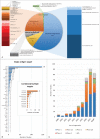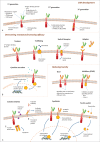CAR-T Cells: Future Perspectives
- PMID: 31723827
- PMCID: PMC6746028
- DOI: 10.1097/HS9.0000000000000188
CAR-T Cells: Future Perspectives
Figures




References
-
- Reddy P, Sokolova A, Chow V, et al. Eligibility for CAR-T trials: an analysis of selection criteria and survival outcomes in chemorefractory DLBCL. ASH Annual Meeting San Diego;. 2018. - PubMed
Publication types
LinkOut - more resources
Full Text Sources
